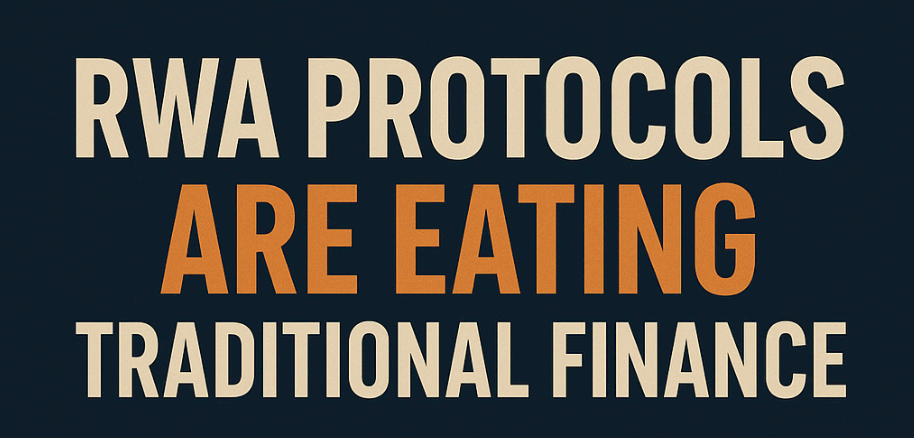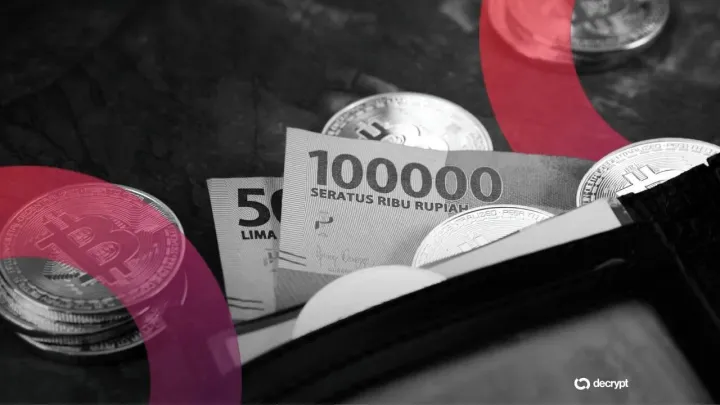RWA Protocols Are Eating Traditional Finance

Introduction: The Financial Paradigm Shift
Imagine a world where your crypto wallet gives you direct exposure to U.S. Treasury bills, private credit markets, or commercial real estate, all while earning yield 24/7 and settling transactions in minutes instead of days. That world isn’t some distant vision. It’s happening now, and it’s being driven by Real-World Asset (RWA) protocols.
RWAs refer to physical or off-chain financial assets that are tokenized and represented on the blockchain. From stable income through tokenized government bonds to under-collateralized loans for small businesses, RWA protocols are bridging the gap between TradFi (traditional finance) and DeFi (decentralized finance). But more than just bridging it, they’re starting to dismantle the wall altogether.
What Are RWAs in Crypto?
RWAs bring tangible, off-chain assets into the crypto ecosystem by representing them as on-chain tokens. These include tokenized versions of Treasury bills, invoices, real estate, carbon credits, and even music royalties. The idea is simple but powerful: bring the benefits of blockchain—transparency, instant settlement, composability—to markets that have long suffered from inefficiency and inaccessibility.
These tokenized assets often follow familiar token standards like ERC-20 or newer ones tailored to compliance (like ERC-3643). A key part of the process involves legal and custodial frameworks that ensure the real-world asset is properly managed while the token acts as a legitimate claim on it.
Why Now?
Several forces have aligned to supercharge the RWA movement:
- Macro Conditions: Higher interest rates have made yield-bearing RWAs extremely attractive to DeFi users who previously relied on speculative tokens for returns.
- Institutional Appetite: Big players want blockchain exposure but need real-world utility and regulatory clarity.
- Improved Infrastructure: Better stablecoins, legal wrappers, oracles, and KYC layers are making it possible to tokenize and trade RWAs in a secure and compliant manner.
- TradFi Shortcomings: The legacy system remains plagued by long settlement times, limited access, and centralized gatekeeping.
The RWA Power Players
- Ondo Finance: Known for its tokenized Treasury products like $OUSG and $USDY, Ondo partners with giants like BlackRock and is rapidly expanding to multiple chains.
- Centrifuge: Is focused on bringing credit markets on-chain, Centrifuge enables protocols like MakerDAO to back DAI with real-world loans.
- Maple Finance: Specializes in under-collateralized lending with on-chain credit delegation and institutional-grade borrowers.
- Goldfinch, TrueFi, Credix: Emerging protocols tackling credit in developing markets, using KYC-gated DeFi and risk-tranching to onboard more conservative capital.
Use Cases in the Wild
- Stablecoin Reserves: Circle (USDC), MakerDAO (DAI), and Ethena (USDe) now back stablecoins with real-world income-generating assets like T-bills.
- On-Chain Savings Accounts: Users can deposit crypto and receive tokenized yields from U.S. government debt.
- Small Business Credit: SMEs in emerging markets are accessing working capital through DeFi rails.
- Carbon Markets and Beyond: Everything from carbon offsets to art and music royalties is being fractionalized and traded on-chain.
Risks and Challenges
- Regulation: Securities laws, KYC/AML requirements, and global regulatory inconsistencies present major hurdles.
- Custodianship: True decentralization is hard when someone has to physically hold or manage the off-chain asset.
- Liquidity Limitations: Tokenized doesn’t always mean easily tradable—especially for niche or long-tail assets.
- Counterparty Risk: Asset originators and custodians can default, mismanage, or act maliciously.
RWA Protocols vs TradFi
| Feature | RWA Protocols | Traditional Finance |
|---|---|---|
| Access | Global, 24/7 | Restricted by jurisdiction |
| Transparency | On-chain, auditable | Opaque systems |
| Yield | Programmable | Bank-controlled |
| Settlement | Near-instant | T+2 or T+3 days |
| Customization | Composable | Rigid & siloed |
It’s clear: RWA protocols aren’t just playing catch-up. In many areas, they’re outperforming traditional systems by orders of magnitude.
The Road Ahead
- Institutional Adoption: JPMorgan’s Onyx platform and BlackRock’s tokenization pilots signal the direction big finance is heading.
- DeFi Collateral: Tokenized RWAs are becoming base-layer collateral for stablecoins, lending, and derivatives.
- Dedicated Chains for RWAs: Expect rollups or appchains custom-built for KYC-heavy, compliant asset trading.
- Battle of Philosophies: Open, permissionless RWA platforms will compete with closed, permissioned walled gardens.
Conclusion:
RWA protocols are not just bolting TradFi onto DeFi. They’re creating a more efficient, transparent, and inclusive financial system from the ground up. With rising interest, improved infrastructure, and use cases expanding by the day, these protocols are poised to disrupt trillions in legacy value.
In the future, your crypto wallet might look more like a Bloomberg Terminal, but sleeker, smarter, and fully programmable. The tokenization of everything has begun. And TradFi should be paying close attention.


Comments ()